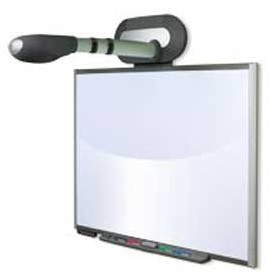Interactive whiteboards general information

Moly Interactive whiteboard general overview
To use an interactive whiteboard, you will need a multimedia projector and a computer. The multimedia projector connects to the monitor socket from either a desktop or notebook computer and projects the computers image onto the interactive whiteboard, which then acts like a projector screen.
There were originally two types of interactive whiteboards: pen (works on electromagnetic technology), and finger (resistive technology). Now there are dual touch and multi-touch boards which allow more than one user to write on the board simultaneously.
A computer is normally controlled by a mouse but you can touch the interactive whiteboard to control the mouse cursor instead. As you move your finger or special pen across the whiteboard, which has the computers image on it, the mouse cursor follows, as shown in the picture below. You simply tap the screen twice with your finger or special pen to perform the normal double-click you would do with the mouse.This is excellent, as it allows you to do all this from the front of the classroom or meeting room. The interactive whiteboard just connects via a cable into the mouse socket on the computer.
The finger touch (resistive) whiteboards are ideal for primary schools where young children can move their finger across the whiteboard for full interactivity.Secondary schools, where pupils are used to using pens, may choose an electromagnetic whiteboard which uses special pens.Some manufacturers produce both pen and finger touch boards which means if a school campus has both types of whiteboards on-site, pupils and teachers only have to learn one set of software.Corporate and training organizations can choose the best type of digital whiteboard to suit their own needs.For instance, in medical environments, touch screen may be favoured for dragging across photos, medical diagrams and slide images, all with the touch a finger. In the business environment, as staff naturally use pens, an interactive whiteboard may be preferred. Whiteboard comparisons.
All interactive whiteboards come with software,to enable you to use it as a copyboard.You can write or draw on the whiteboard with your finger or the pens provided and save the image to the computer.These images, which are your notes from the meeting or training session, can then be printed or emailed.The software that comes with some interactive whiteboards may have built in OCR which is Optical Character Recognition, which means can write on screen and the computer will recognize your handwriting and turn it into computer text.

Interactive whiteboard
Interactive whiteboards can be used to:
·Write over the top of programs to highlight and annotate points (see picture above).
·View and navigate the Internet from the whiteboard. Surf and display websites which the entire room will be able to see.
·Students/audience members can approach the whiteboard and add their contribution to the discussion by writing directly on the whiteboard.
·Present ideas to large audiences.
·Display movie files or DVD's from the PC
·Work on word processing documents, spreadsheets, design projectors with your colleagues. Can be connected to video conferencing systems.
The interactive whiteboards needs to know where you are touching on screen and therefore use one of two technologies for this, which are:
·Resistive technology (finger touch) - Two pieces of resistive material with a small gap between them are used to detect where a person touches the screen.The co-ordinates correspond to the area on the computer monitor. The advantage of whiteboards based on resistive technology is that you do not require a special stylus to write on the board, a finger can be used just as well. SMART Boards,MOLYBoard,and PolyVision interactive whiteboards use this technology.
·Electromagnetic scanning technology (pen) - This uses special pens and the frame of the whiteboard detects where the pen is on screen. Because of this, if the whiteboard screen is damaged you can just replace the screen. The electromagnetic interactive whiteboards normally come with several pens.Promethean ACTIVboard,MOLYBoard,and InterWrite interactive whiteboards use this technology. Hitachi FX Duoboards allow you to use an electronic pen and finger touch, thus benefiting from both technologies.
Interactive whiteboards are available in front or rear projection formats:
Front projection interactive whiteboards

Front projection interactive whiteboards
As you can see from the above picture, the projector sits in front of the whiteboard and shines the computer image onto the screen. In this case they have situated the projector on the table, but projectors can also be ceiling mounted. This is front projection. Rear projection is where the projector is out of sight behind the whiteboard. Rear projection is 2-3 times more expensive than a front projection setup.
Front projection whiteboards range in size from around 48" to 115" in diagonal size; with 60-inch and 77-inch being popular sizes.60" doesn't sound huge, but it fits into school environments well as otherwise pupils cannot reach the middle of boards to contribute. They come either with a wall mount bracket, desktop stand or floor stand on wheels.
Portable versions are also available for presentations on the move. These tend to be around 47" screens to keep the weight down. You still need to take a computer with you, usually a notebook, and also a projector which can weigh as little as 0.9kg.
Setting up an interactive whiteboard is very straight forward and all come with full instructions:
·Plug in and switch-on the whiteboard, computer and projector.
·Connect the computer to the projector with a single cable (provided).
This projects the computer image onto the whiteboard. You will just have to adjust the focus and zoom to get the projectors image to fit of the whiteboard nicely.
·Connect the USB cable provided from the whiteboard to a USB port on the computer.
Easy to follow diagrams come with the whiteboard.
·Load the software CD that is included with the whiteboard, onto the computer.
This software talks you through the registration of the whiteboard, which just involves touching the whiteboard on a series of crosses. Registration lets the whiteboard know were the cursor is on screen.
The computer software only needs loading once on either a desktop or notebook computer. The software will work with both PC's and Apple Macintosh computers.
Whiteboard software
Software which comes with your interactive whiteboard varies, depending on the market that the board manufacturer is aiming for.
Integral whiteboards and projectors

Smart Board Unifi integral interactive whiteboard, projector and sound
Many schools are now using short throw projectors, due to Health & Safety reasons. When a projector is mounted a few metres away from the whiteboard, the bright light can shine in the teacher's and pupil's eyes. Whiteboard manufacturers Promethean and SMART Board both produce integral solutions comprising of an interactive whiteboard on a wall frame, which incorporates a projector on a boom arm.Depending on manufacturer, the wall frame may be height adjustable which makes it ideal for small children or people in wheelchairs.
Interactive Panels, wireless pads and voting systems
Some interactive whiteboard manufacturers offer a suite of interactive solutions, for example, MOLYBoard have MOLY interactive whiteboards; MolyPad, Moly wireless tablet;Moly interactive panel and MOLYVote (voting system). Should you wish to use other interactive solutions in the future it is worth checking what options are available prior to making your interactive whiteboard purchase. Interactive whiteboards Interactive panels Wireless tablets Voting systems
There are manufacturers who make, for example, voting systems which are designed to work with their own interactive whiteboard, whilst others make systems to work with any interactive whiteboard for the education or corporate / pubs and clubs / TV studio audience market. Voting systems |

